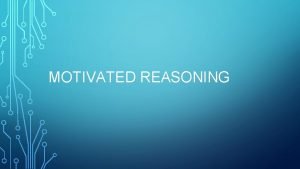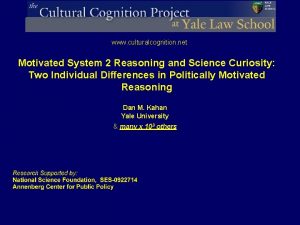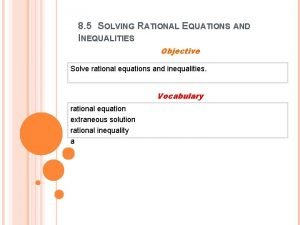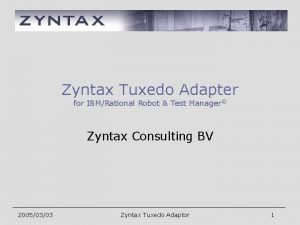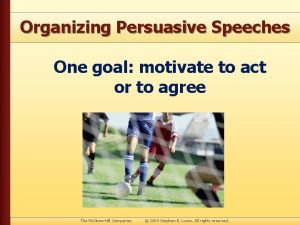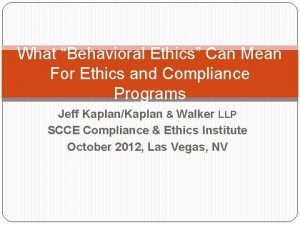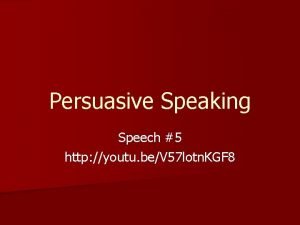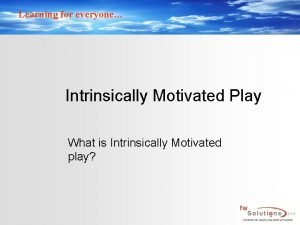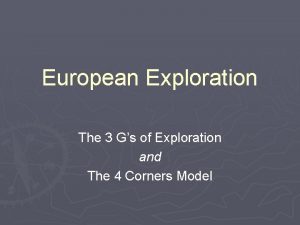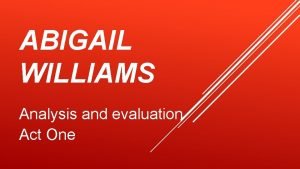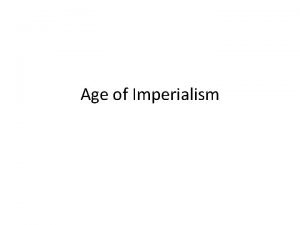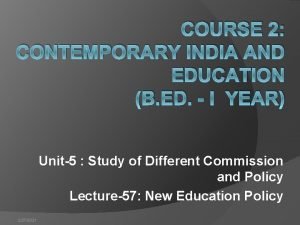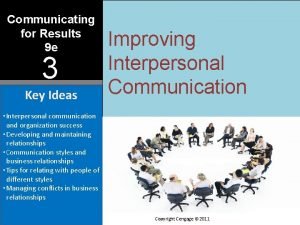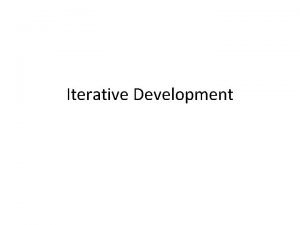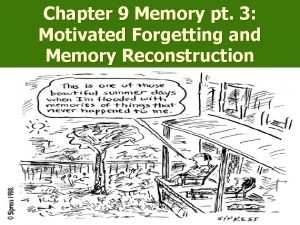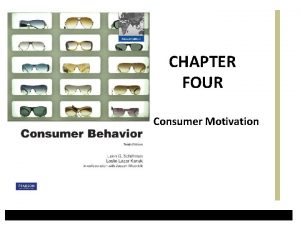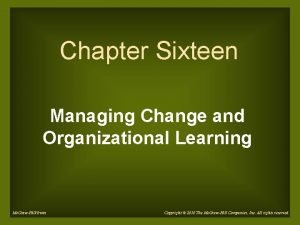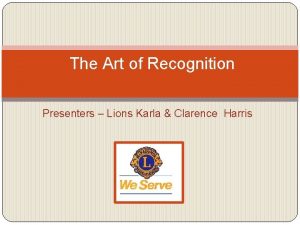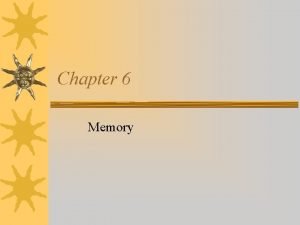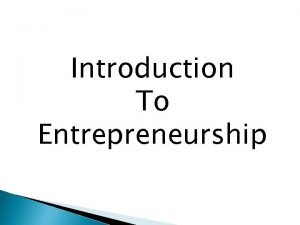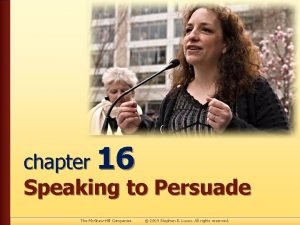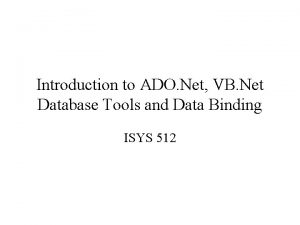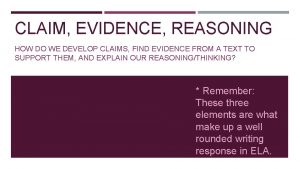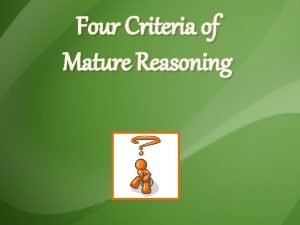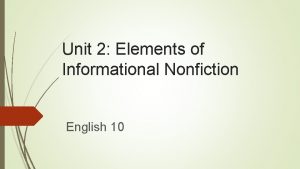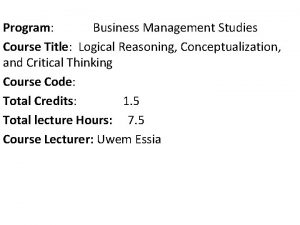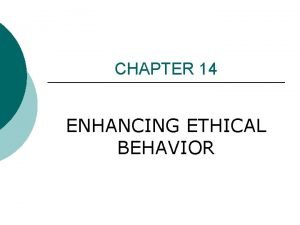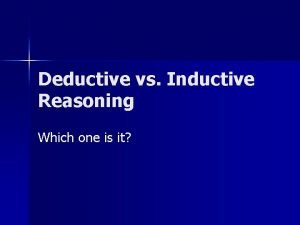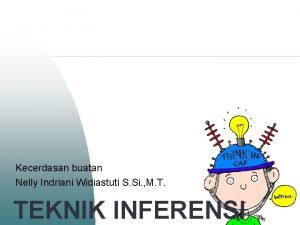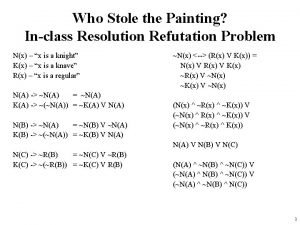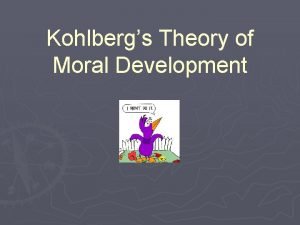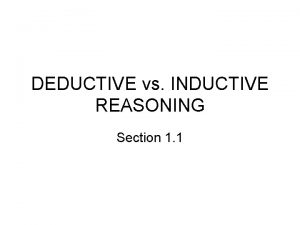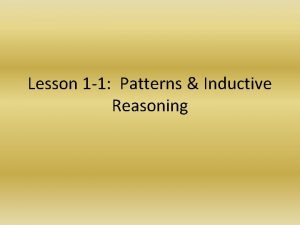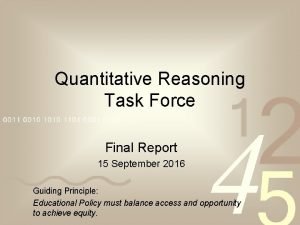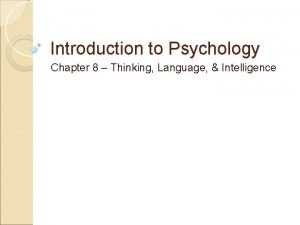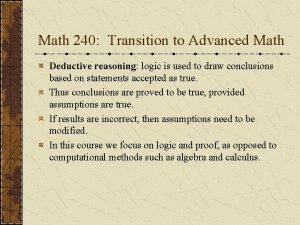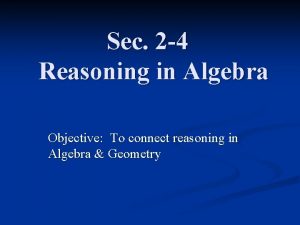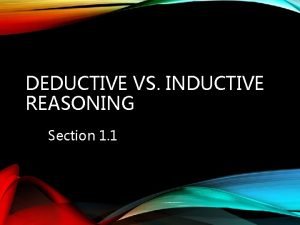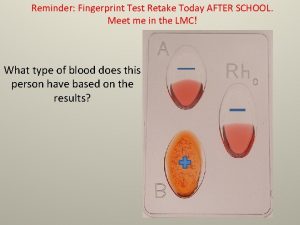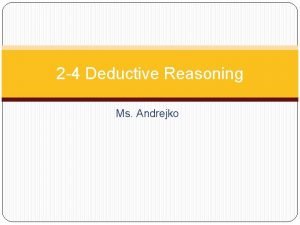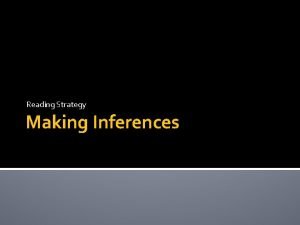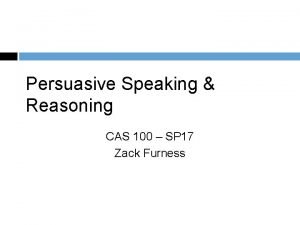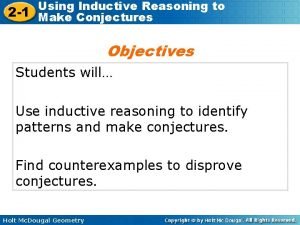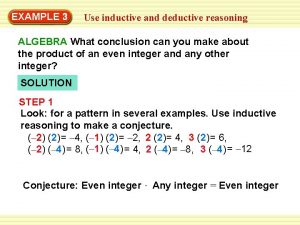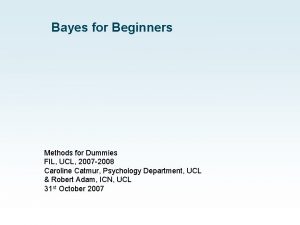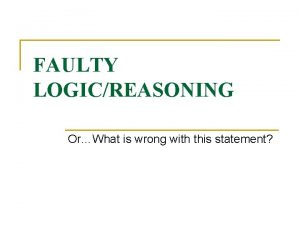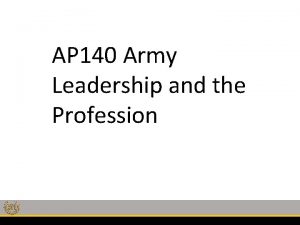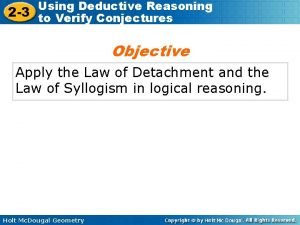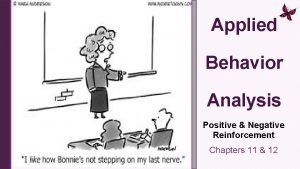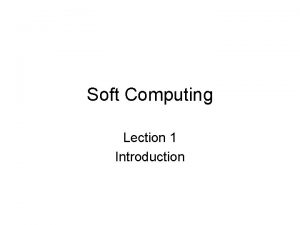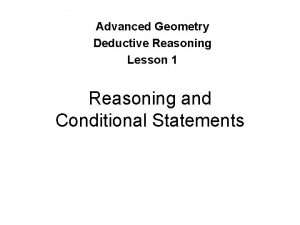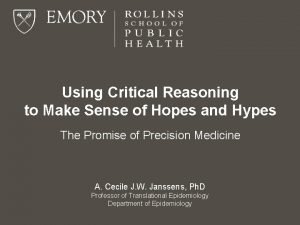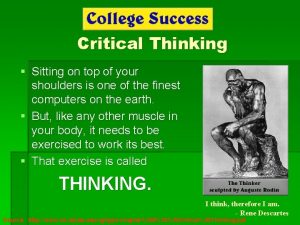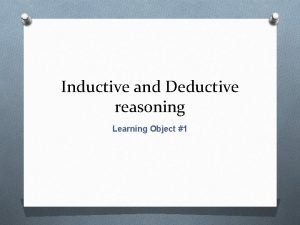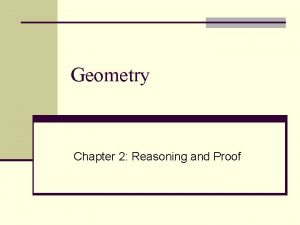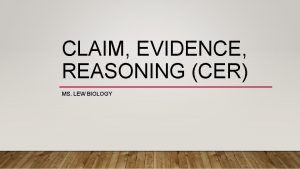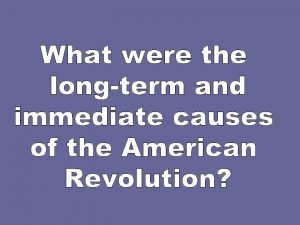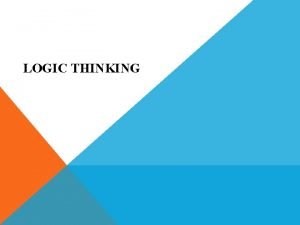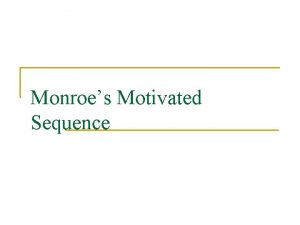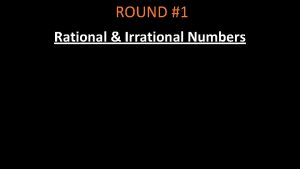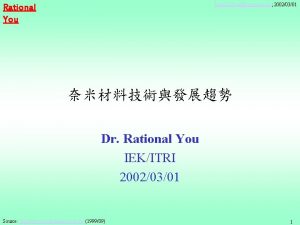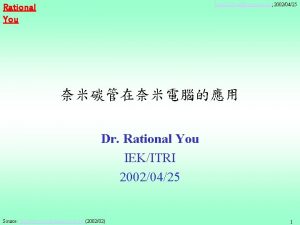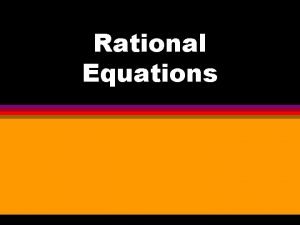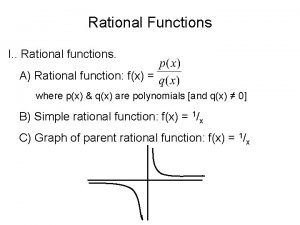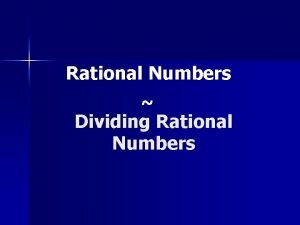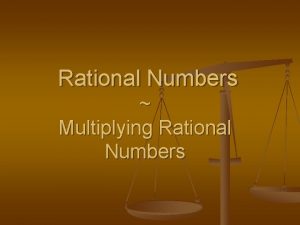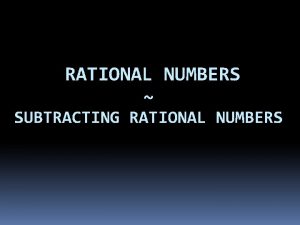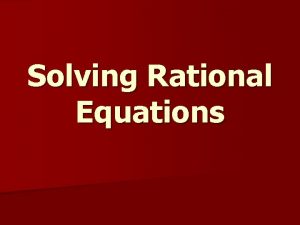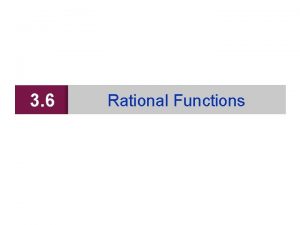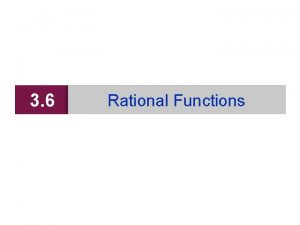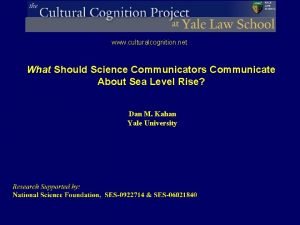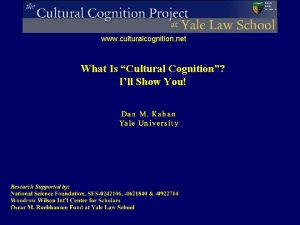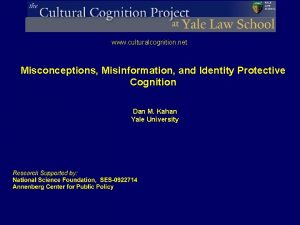www culturalcognition net Is Ideologically Motivated Reasoning Rational






















































































- Slides: 86

www. culturalcognition. net Is Ideologically Motivated Reasoning Rational? And Do Only Conservatives Engage In It? !

What am I talking about? . . . I. “Modeling” motivated reasoning II. The Cultural cognition of risk (& other things) III. Ideology, cognitive reflection & motivated reasoning

Bayesian Information Processing New Evidence Revised Factual Belief Prior Factual Belief prior odds X likelihood ratio = posterior odds

Confirmation Bias New Evidence Revised Factual Belief Prior Factual Belief prior odds X likelihood ratio = posterior odds

Motivated Reasoning New Evidence Extrinsic Goal/Interest Revised Factual Belief Prior Factual Belief prior odds X likelihood ratio = posterior odds

Spurious Motivated confirmation Reasoning bias New Evidence Extrinsic Goal/Interest Revised Factual Belief Prior Factual Belief prior odds X likelihood ratio = posterior odds

Motivated Reasoning New Evidence Extrinsic Goal/Interest Revised Factual Belief Prior Factual Belief prior odds X likelihood ratio = posterior odds

Ideologically Motivated Reasoning Ideological Predisposition New Evidence Revised Factual Belief Prior Factual Belief prior odds X likelihood ratio = posterior odds


Spurious Motivated confirmation Reasoning bias Ideological Predisposition New Evidence Revised Factual Belief Prior Factual Belief prior odds X likelihood ratio = posterior odds

What am I talking about? . . . II. “Modeling” motivated reasoning The Cultural cognition of risk (& other things) III. Ideology, cognitive reflection & motivated reasoning

Cultural Motivated Cognition Reasoning of Risk New Evidence Extrinsic Goal/Interest Revised Factual Belief Prior Factual Belief prior odds X likelihood ratio = posterior odds

Cultural Motivated Cognition Reasoning of Risk Cultural Predisposition New Evidence Revised Factual Belief Prior Factual Belief prior odds X likelihood ratio = posterior odds

Mary Douglas’s Group-grid worldview scheme Risk Perception Key Low Risk High Risk Hierarchy Environment: climate, nuclear hierarchical individualists Guns/Gun Control HPV Vaccination Gays military/gay parenting hierarchical communitarians Abortion procedure compulsory psychiatric treatment Individualism Gays military/gay parenting Abortion procedure egalitarian individualists compulsory psychiatric treatment Communitarianism Environment: climate, nuclear Guns/Gun Control egalitarian communitarians HPV Vaccination Egalitarianism

Cultural Cognition of Risk Cultural Predisposition New Evidence Revised Factual Belief Prior Factual Belief prior odds X likelihood ratio = posterior odds

Identity Protective Cognition 38

Mechanisms of cultural cognition § § § Culturally biased search & assimilation Cultural credibility heuristic Cultural availability effect Identity-affirmation Culturally motivated “system 2” reasoning


Perceive Benefits > Risks 100% 75% 50% 25% 0% * Change across conditions significant at p < 0. 05 Source: Kahan , Braman, Slovic, Gastil & Cohen Cultural Cognition of Nanotechnology Risks and Benefits, Nature Nanotechnology, 4(2), 87 -91 (2009)

Perceive Benefits > Risks 100% 75% 50% 25% 0% * Change across conditions significant at p < 0. 05 Source: Kahan , Braman, Slovic, Gastil & Cohen Cultural Cognition of Nanotechnology Risks and Benefits, Nature Nanotechnology, 4(2), 87 -91 (2009)

Perceive Benefits > Risks 100% 75% 50% 25% 0% * Change across conditions significant at p < 0. 05 Source: Kahan , Braman, Slovic, Gastil & Cohen Cultural Cognition of Nanotechnology Risks and Benefits, Nature Nanotechnology, 4(2), 87 -91 (2009)

Perceive Benefits > Risks Information effect: familiarity Information effect: culture

Perceive Benefits > Risks Information effect: familiarity Information effect: culture

High Risk Moderate Risk Slight Risk Almost No Risk n = 1, 820 to 1, 830. Risk variables are 4 -pt measures of “risk to people in American Society” posed by indicated risk. Differences between group means all significant at p ≤. 01.

Perceive Benefits > Risks Information effect: familiarity Information effect: culture

Increase in Predicted Likelihood of Self. Reported Familiarity with Nanotechnology 25% 20% 19. 5% Hierarch 15% 10% 5. 8% 5% 3. 6% 2. 2% 0. 9% Egalitarian 0% -0. 5% -0. 9% -1. 4% -2. 6% -5% 1 st Communitarian 20 th 40 th 60 th 80 th Percentile Figure S 1 Source: Kahan , Braman, Slovic, Gastil & Cohen Cultural Cognition of Nanotechnology Risks and Benefits, Nature Nanotechnology, 4(2), 87 -91 (2009) 99 th Individualistic

Cultural Cognition of Risk New Evidence Cultural Worldview Revised Factual Belief Prior Factual Belief prior odds X likelihood ratio = posterior odds

Cultural Cognition of Risk New Evidence Cultural Worldview Revised Factual Belief Prior Factual Belief prior odds X likelihood ratio = posterior odds

Mechanisms of cultural cognition § § § Culturally biased search & assimilation Cultural credibility heuristic Cultural availability effect Identity-affirmation Culturally motivated “system 2” reasoning

Cultural Cognition of Risk Cultural Predisposition New Evidence Revised Factual Belief Prior Factual Belief prior odds X likelihood ratio = posterior odds

Spurious confirmation bias Cultural Predisposition New Evidence Revised Factual Belief Prior Factual Belief prior odds X likelihood ratio = posterior odds

Cultural Cognition of Risk Cultural Predisposition New Evidence Revised Factual Belief Prior Factual Belief prior odds X likelihood ratio = posterior odds


Control Condition

Anti-pollution Condition

Geoengineering Condition

Polarization z_Study dismiss 2 more polarization less polarization anti-pollution Kahan, Jenkins-Smith, Tarantola, Silva & Braman, Geoengineering and the Science Communication Environment, CCP Working Paper No. 92 (Jan. 9, 2012), available at http: //papers. ssrn. com/sol 3/papers. cfm? abstract_id=1981907

Mechanisms of cultural cognition § § § Culturally biased search & assimilation Cultural credibility heuristic Cultural availability effect Identity-affirmation Culturally motivated “system 2” reasoning

Kahan, D. M. , Peters, E. , Wittlin, M. , Slovic, P. , Ouellette, L. L. , Braman, D. & Mandel, G. The polarizing impact of science literacy and numeracy on perceived climate change risks. Nature Climate Change 2, 732 -735 (2012).

Two Hypotheses 1. Public Irrationality Thesis (PIT) • • “science illiteracy” “bounded rationality” 2. Cultural cognition thesis (CCT)

“How much risk do you believe climate change poses to human health, safety, or prosperity? ” perceived risk (z-score) Greater Lesser

“How much risk do you believe climate change poses to human health, safety, or prosperity? ” PIT prediction: Science Illiteracy & Bounded Rationality Greater perceived risk (z-score) High Sci. litearcy/System 2 (“slow”) Low Sci. litearcy/System 1 (“fast”) Lesser

“How much risk do you believe climate change poses to human health, safety, or prosperity? ” perceived risk (z-score) Greater Risk Lesser Risk PIT prediction actual variance low high Science literacy actual variance low high Numeracy

“How much risk do you believe climate change poses to human health, safety, or prosperity? ” Cultural variance conditional on sci. literacy/numeracy? Cultural Variance perceived risk (z-score) Greater Lesser Egalitarian Communitarian Low Sci lit/numeracy High Sci lit/numeracy Hierarchical Individualist

“How much risk do you believe climate change poses to human health, safety, or prosperity? ” PIT prediction: Culture as heuristic substitute perceived risk (z-score) Greater Lesser Egalitarian Communitarian Low Sci lit/numeracy High Sci lit/numeracy Hierarchical Individualist

“How much risk do you believe climate change poses to human health, safety, or prosperity? ” Actual interaction of culture & sci-lit/num. . . perceived risk (z-score) Greater Lesser High Sci lit/numeracy Egal Comm Low Sci/lit numeracy Egal Comm Low Sci lit/numeracy Low Sci lit/num. Hierarc Individ High Sci lit/numeracy Hierarch Individ

“How much risk do you believe climate change poses to human health, safety, or prosperity? ” Actual interaction of culture & sci-lit/num. . . perceived risk (z-score) Greater Lesser High Sci lit/numeracy Egal Comm Low Sci/lit numeracy Egal Comm Low Sci lit/numeracy Low Sci lit/num. Hierarc Individ High Sci lit/numeracy Hierarch Individ

“How much risk do you believe climate change poses to human health, safety, or prosperity? ” POLARIZATION INCREASES as scil-lit/numeracy increases perceived risk (z-score) Greater Lesser High Sci lit/numeracy Egal Comm Low Sci/lit numeracy Egal Comm Low Sci lit/numeracy Low Sci lit/num. Hierarc Individ High Sci lit/numeracy Hierarch Individ

Cultural Cognition of Risk New Evidence Cultural Worldview System 1 and System 2 Revised Factual Belief Prior Factual Belief prior odds X likelihood ratio = posterior odds

Mechanisms of cultural cognition § § § Culturally biased search & assimilation Cultural credibility heuristic Cultural availability effect Identity-affirmation Culturally motivated “system 2” reasoning

What am I talking about? . . . I. “Modeling” motivated reasoning II. The Cultural cognition of risk (& other things) III. Ideology, cognitive reflection & motivated reasoning


“Asymmetry thesis”

Cultural Cognition Cultural Predisposition New Evidence System 1 and System 2 Revised Factual Belief Prior Factual Belief prior odds X likelihood ratio = posterior odds

Identity Protective Cognition 38

Identity Protective Cognition

Study design Sample 1, 800 adults drawn from nationally representative on-line panel Measures § § § Political ideology & party affiliation Cognitive reflection test (CRT) Perceived validity of CRT Experimental Manipulation control vs. “skeptic-is-biased” & “nonskeptic-is-biased”

Study design Sample 1, 800 adults drawn from nationally representative on-line panel Measures § § § Political ideology & party affiliation Cognitive reflection test (CRT) Perceived validity of CRT Experimental Manipulation control vs. “skeptic-is-biased” & “nonskeptic-is-biased”

Study design Sample 1, 800 adults drawn from nationally representative on-line panel Measures § § § Political ideology & party affiliation Cognitive reflection test (CRT) Perceived validity of CRT Experimental Manipulation control vs. “skeptic-is-biased” & “nonskeptic-is-biased”

Study design Sample 1, 800 adults drawn from nationally representative on-line panel Measures § § § Political ideology & party affiliation Cognitive reflection test (CRT) Perceived validity of CRT Experimental Manipulation control vs. “skeptic-is-biased” & “nonskeptic-is-biased”

Likelihood of Score Finding # 1. Political differences in CRT are trivial Democrat Republican CRT Score N = 1600. Derived from ordered logit regression. Outcome variable is CRT score. Predictor is 7 -point partisan self-identification measure. Predictor value set at 2 for “Democrat” and 6 for “Republican. ” CIs are 0. 95 level of confidence.

CRT Score Likelihood of Score

Study design Sample 1, 800 adults drawn from nationally representative on-line panel Measures § § § Political ideology & party affiliation Cognitive reflection test (CRT) Perceived validity of CRT Experimental Manipulation control vs. “skeptic-is-biased” & “nonskeptic-is-biased”

Study design Sample 1, 800 adults drawn from nationally representative on-line panel Measures § § § Political ideology & party affiliation Cognitive reflection test (CRT) Perceived validity of CRT Experimental Manipulation control vs. “skeptic-is-biased” & “nonskeptic-is-biased”

Psychologists believe the questions you have just answered measure how reflective and open-minded someone is. How strongly do you agree or disagree with this statement? [strongly disagree, moderately disagree, slightly agree, moderately disagree, strongly disagree] “I think the word-problem test I just took supplies good evidence of how reflective and open-minded someone is. ”

Study design Sample 1, 800 adults drawn from nationally representative on-line panel Measures § § § Political ideology & party affiliation Cognitive reflection test (CRT) Perceived validity of CRT Experimental Manipulation control vs. “skeptic-is-biased” & “nonskeptic-is-biased”

Study design Sample 1, 800 adults drawn from nationally representative on-line panel Measures § § § Political ideology & party affiliation Cognitive reflection test (CRT) Perceived validity of CRT Experimental Manipulation control vs. “skeptic-is-biased” & “nonskeptic-is-biased”

1. Control condition Psychologists believe the questions you have just answered measure how reflective and open-minded someone is. . 2. Skeptic-is-biased condition. . . In one recent study, a researcher found that people who accept evidence of climate change tend to get more answers correct than those who reject evidence of climate change. If the test is a valid way to measure open-mindedness, that finding would imply that those who believe climate change is happening are more open-minded than those who are skeptical that climate change is happening. . 3. Nonskeptic-is-biased condition. . . In one recent study, a researcher found that people who reject evidence of climate change tend to get more answers correct than those who accept evidence of climate change. If the test is a valid way to measure open-mindedness, that finding would imply that those who are skeptical that climate change is happening are more open-minded than those who believe climate change is happening. .

1. Control condition Psychologists believe the questions you have just answered measure how reflective and open-minded someone is. . 2. Skeptic-is-biased condition. . . In one recent study, a researcher found that people who accept evidence of climate change tend to get more answers correct than those who reject evidence of climate change. If the test is a valid way to measure open-mindedness, that finding would imply that those who believe climate change is happening are more open-minded than those who are skeptical that climate change is happening. . 3. Nonskeptic-is-biased condition. . . In one recent study, a researcher found that people who reject evidence of climate change tend to get more answers correct than those who accept evidence of climate change. If the test is a valid way to measure open-mindedness, that finding would imply that those who are skeptical that climate change is happening are more open-minded than those who believe climate change is happening. .

“Asymmetry thesis”

Ideologically Motivated Reasoning New Evidence Ideological Predisposition Revised Factual Belief Prior Factual Belief prior odds X likelihood ratio = posterior odds

Ideologically Motivated Reasoning Other side’s New CRT score Evidence Ideological Predisposition Revised: other side displays IMR Prior: other side displays IMR prior odds X likelihood ratio = posterior odds

Ideologically Motivated Reasoning New Evidence Ideological Predisposition Revised Factual Belief Prior Factual Belief prior odds X likelihood ratio = posterior odds

Study design Sample 1, 800 adults drawn from nationally representative on-line panel Measures § § § Political ideology & party affiliation Cognitive reflection test (CRT) Perceived validity of CRT Experimental Manipulation control vs. “skeptic-is-biased” & “nonskeptic-is-biased” Kahan, Ideology, Motivated Reasoning, and Cognitive Reflection, CCP Working Paper No. 107 (Nov. 19, 2012), available at http: //papers. ssrn. com/sol 3/papers. cfm? abstract_id=2182588

Finding # 2. Ideologically biased assimilation of “validity of CRT” “nonskeptic is biased” control “skeptic is biased” Fitted ordered-logit regression analysis values. Y-axis reflects predicted probability of agreeing either “slightly, ” “moderately, ” or “strongly” with CRT_valid.

Study design Sample 1, 800 adults drawn from nationally representative on-line panel Measures § § § Political ideology & party affiliation Cognitive reflection test (CRT) Perceived validity of CRT Experimental Manipulation control vs. “skeptic-is-biased” & “nonskeptic-is-biased” Kahan, Ideology, Motivated Reasoning, and Cognitive Reflection, CCP Working Paper No. 107 (Nov. 19, 2012), available at http: //papers. ssrn. com/sol 3/papers. cfm? abstract_id=2182588

Study design Sample 1, 800 adults drawn from nationally representative on-line panel Measures § § § Political ideology & party affiliation Cognitive reflection test (CRT) Perceived validity of CRT Experimental Manipulation control vs. “skeptic-is-biased” & “nonskeptic-is-biased” Kahan, Ideology, Motivated Reasoning, and Cognitive Reflection, CCP Working Paper No. 107 (Nov. 19, 2012), available at http: //papers. ssrn. com/sol 3/papers. cfm? abstract_id=2182588

Finding # 2. Ideologically biased assimilation of “validity of CRT” “nonskeptic is biased” control “skeptic is biased” Fitted ordered-logit regression analysis values. Y-axis reflects predicted probability of agreeing either “slightly, ” “moderately, ” or “strongly” with CRT_valid.

Finding # 3. Ideologically biased assimilation increases with CRT Note. N = 1750. Derived from ordered logit regression. Point estimates of predicted likelihood of agreeing (slightly, moderately or strongly) that CRT test is valid. CIs are 0. 95 level of confidence.

1. Control condition Psychologists believe the questions you have just answered measure how reflective and open-minded someone is. . 2. Skeptic-is-biased condition. . . In one recent study, a researcher found that people who accept evidence of climate change tend to get more answers correct than those who reject evidence of climate change. If the test is a valid way to measure open-mindedness, that finding would imply that those who believe climate change is happening are more open-minded than those who are skeptical that climate change is happening. . 3. Nonskeptic-is-biased condition. . . In one recent study, a researcher found that people who reject evidence of climate change tend to get more answers correct than those who accept evidence of climate change. If the test is a valid way to measure open-mindedness, that finding would imply that those who are skeptical that climate change is happening are more open-minded than those who believe climate change is happening. .

Is Ideologically Motivated Reasoning Rational? And Do Only Conservatives Engage In It? ! vs.

Is Ideologically Motivated Reasoning Rational? And Do Only Conservatives Engage In It? !

Did protestors cross the line between “speech” and “intimidation”? source: Dan M. Kahan, David A. Hoffman, Donald Braman, Danieli Evans & Jeffrey J. Rachlinski, They Saw a Protest : Cognitive Illiberalism and the Speech-Conduct Distinction, 64 Stan. L. Rev. (forthcoming 2012)

Experimental Conditions Abortion Clinic Condition Recruitment Center Condition source: Dan M. Kahan, David A. Hoffman, Donald Braman, Danieli Evans & Jeffrey J. Rachlinski, They Saw a Protest : Cognitive Illiberalism and the Speech-Conduct Distinction, 64 Stan. L. Rev. (forthcoming 2011)

Pct. Agree Protestors blocked Screamed in face Pedestrians just not want to listen Police just annoyed

Cultural Cognition Cat Scan Experiment Go to www. culturalcognition. net!
 Motivated reasoning
Motivated reasoning Motivated system 2 reasoning
Motivated system 2 reasoning Inductive method definition
Inductive method definition Difference of inductive and deductive reasoning
Difference of inductive and deductive reasoning Deductive reasoning vs inductive reasoning
Deductive reasoning vs inductive reasoning Every quiz has been easy. therefore the quiz will be easy
Every quiz has been easy. therefore the quiz will be easy Inductive reasoning vs deductive reasoning
Inductive reasoning vs deductive reasoning Patterns and inductive reasoning
Patterns and inductive reasoning Inductive reasoning definition
Inductive reasoning definition Rational equation and rational inequalities
Rational equation and rational inequalities Tux robot
Tux robot Basic model of motivation
Basic model of motivation Attention need satisfaction visualization action
Attention need satisfaction visualization action Monroe's motivated sequence
Monroe's motivated sequence Knowdell card sorts
Knowdell card sorts Define motivated forgetting
Define motivated forgetting When are capabilities-motivated acquisitions essential?
When are capabilities-motivated acquisitions essential? Motivated blindness
Motivated blindness Reported speech persuade
Reported speech persuade Motivated learning for everyone
Motivated learning for everyone Reasons for exploration 3 g's
Reasons for exploration 3 g's Abigail williams in act 1
Abigail williams in act 1 Between 1859 and 1893 vietnam
Between 1859 and 1893 vietnam Motivated energized and capable faculty
Motivated energized and capable faculty Which communicator is motivated by mistrust of others?
Which communicator is motivated by mistrust of others? Motivated last thing you want do
Motivated last thing you want do Define motivated forgetting
Define motivated forgetting Motivation process
Motivation process Which of the following forces motivated change at h&b
Which of the following forces motivated change at h&b Lions are motivated by recognition
Lions are motivated by recognition Hawthorne motivation
Hawthorne motivation Motivated forgetting that occurs unconsciously is known as:
Motivated forgetting that occurs unconsciously is known as: Tenacity despite failure in entrepreneurship
Tenacity despite failure in entrepreneurship Mc-graw hill
Mc-graw hill Achmed lach net ich krieg mein tach net
Achmed lach net ich krieg mein tach net Ado.net vb.net
Ado.net vb.net Mr xavier mystery claim evidence reasoning
Mr xavier mystery claim evidence reasoning Four criteria
Four criteria Elements of informational nonfiction
Elements of informational nonfiction What is logical reasoning
What is logical reasoning Argument by analogy
Argument by analogy Examples of moral
Examples of moral Key stage 1 reasoning paper 2018
Key stage 1 reasoning paper 2018 Perceptual reasoning
Perceptual reasoning Lossless decomposition in dbms ppt
Lossless decomposition in dbms ppt Inductive reasoning cartoon
Inductive reasoning cartoon Contoh abductive reasoning
Contoh abductive reasoning True reasoning parsons
True reasoning parsons Abductive argument
Abductive argument Argument from analogy
Argument from analogy Kohlberg's theory of moral development stages
Kohlberg's theory of moral development stages Inductive reasoning problem solving examples
Inductive reasoning problem solving examples Creative reasoning definition
Creative reasoning definition Practice 1-1 patterns and inductive reasoning
Practice 1-1 patterns and inductive reasoning 9 problem solving strategies
9 problem solving strategies Instruksi ist
Instruksi ist What is the cost to take the sat reasoning test?
What is the cost to take the sat reasoning test? Define quantitative reasoning
Define quantitative reasoning Thinking chapter in psychology
Thinking chapter in psychology Deductive reasoning math definition
Deductive reasoning math definition 2-4 reasoning in algebra
2-4 reasoning in algebra Inductive reasoning examples
Inductive reasoning examples Claim evidence reasoning sentence starters
Claim evidence reasoning sentence starters Dbq analysis and reasoning
Dbq analysis and reasoning Deductive logic
Deductive logic Inference and conclusion
Inference and conclusion 2-sided organizational refutational pattern
2-sided organizational refutational pattern Using inductive reasoning to make conjectures
Using inductive reasoning to make conjectures Deductive reasoning examples
Deductive reasoning examples Bayesian for dummies
Bayesian for dummies Leq writing
Leq writing Elements of reasoning
Elements of reasoning I am proud that i am humble faulty logic
I am proud that i am humble faulty logic Ethical lenses army
Ethical lenses army Deductive
Deductive Positive reinforcement vs bribery
Positive reinforcement vs bribery Probabilistic reasoning
Probabilistic reasoning Circular reasoning cartoon
Circular reasoning cartoon Deductive reasoning geometry
Deductive reasoning geometry Logical reasoning
Logical reasoning Inductive reasoning in history
Inductive reasoning in history Deductive approach
Deductive approach Inductive reasoning
Inductive reasoning Geometry chapter 2 proofs worksheet
Geometry chapter 2 proofs worksheet Queenie cer
Queenie cer Chronological reasoning
Chronological reasoning Types of inductive reasoning
Types of inductive reasoning
